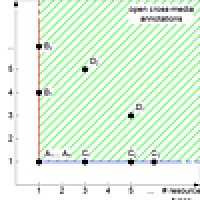A Model and Architecture for Open Cross-Media Annotation and Link Services

Over the last decade, we have seen a tremendous increase in the number of digital media types that we deal with as part of our daily work. While the Web with its linking functionality was originally designed for organising information in the form of HTML documents containing embedded media such as images, movies and sounds, the underlying hypertext model is not flexible enough to deal with new media types. A flexible link and annotation service should not only support a growing set of digital media types, but also pay attention to emerging possibilities for linking and integrating the physical environment with digital information spaces in the form of augmented reality environments. The successful implementation of these so-called cross-media information spaces, where different types of digital information get linked and integrated with physical entities, demands for a rethinking of models and architectures for extensible and scalable cross-media annotation and linking. In this paper, we present our general model for open cross-media annotation and link services and highlight how this model enabled the realisation of an extensible cross-media architecture. We further introduce the concept of open cross-media information spaces where the integration of new media types on the data level as well as on the visualisation level is supported via a resource plug-in mechanism.
Publication Reference
Signer, B. and Norrie, M.C.: "A Model and Architecture for Open Cross-Media Annotation and Link Services", Information Systems 36(3), Elsevier, May 2011
WISE Authors
Related Research Topic(s)
Related Research Project(s)
- iPaper - Interactive Paper Framework for Paper-Digital Integration
- iServer - Cross-Media Link Server



